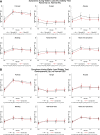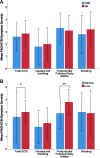Postprandial symptoms in patients with symptoms of gastroparesis: roles of gastric emptying and accommodation
- PMID: 35502871
- PMCID: PMC9236865
- DOI: 10.1152/ajpgi.00278.2021
Postprandial symptoms in patients with symptoms of gastroparesis: roles of gastric emptying and accommodation
Abstract
Patients often are evaluated for gastroparesis because of symptoms occurring with meals. Gastric emptying scintigraphy (GES) is used for gastroparesis diagnosis, although results are not well correlated with gastroparesis symptoms. The aim of this study is to assess relationships between gastroparesis symptoms, gastric emptying (GE), and gastric accommodation (GA). Patients with symptoms of gastroparesis completed the Patient Assessment of Upper GI Symptoms (PAGI-SYM) and recorded symptoms during GES and water load satiety test (WLST), an indirect assessment for GA. A total of 109 patients with gastroparesis symptoms were assessed. Symptom severity increased after GES meal for stomach fullness, belching, nausea, abdominal burning, and abdominal pain. There was no difference in symptoms after meal between patients with delayed (n = 66) and normal (n = 42) GE. Diabetic patients (n = 26) had greater gastric retention than idiopathic patients (n = 78), but idiopathic patients had greater postprandial nausea, stomach fullness, and abdominal pain. Water consumed during WLST averaged 421 ± 245 mL. Idiopathic patients had greater nausea scores during WLST than diabetic patients. In comparison to those with normal water consumption (≥238 mL; n = 80), patients with impaired water ingestion (<238 mL; n = 26) had increased stomach fullness, early satiety, postprandial fullness, and loss of appetite on PAGI-SYM. Patients with delayed and normal GE had similar symptom profiles during GES and WLST. Idiopathic patients had less gastric retention but more symptoms after GES meal and after WLST compared with diabetic patients. Patients with impaired water consumption during WLST had increased symptoms by PAGI-SYM. These data suggest that impaired GA, rather than GE, may be important in explaining postprandial symptoms in patients with symptoms of gastroparesis.NEW & NOTEWORTHY Patients with delayed and normal gastric emptying (GE) had similar symptom profiles during gastric emptying scintigraphy (GES). Idiopathic patients with symptoms of gastroparesis had less gastric retention by GES; but more symptoms after GES meal and after water load satiety test (WLST) compared with diabetic patients. In patients with symptoms of gastroparesis, symptoms after WLST increased with decreasing water consumption. Early satiety and loss of appetite were associated with decreased water consumption during WLST. Thus, impaired accommodation and perhaps visceral hypersensitivity are important in explaining postprandial symptoms in gastroparesis.
Trial registration: ClinicalTrials.gov NCT01696747.
Keywords: gastric accommodation; gastric emptying; gastroparesis.
Conflict of interest statement
No conflicts of interest, financial or otherwise, are declared by the authors.
Figures





Similar articles
-
Relationships among intragastric meal distribution during gastric emptying scintigraphy, water consumption during water load satiety testing, and symptoms of gastroparesis.Am J Physiol Gastrointest Liver Physiol. 2023 Nov 1;325(5):G407-G417. doi: 10.1152/ajpgi.00065.2023. Epub 2023 Aug 8. Am J Physiol Gastrointest Liver Physiol. 2023. PMID: 37552206 Free PMC article.
-
Early satiety and postprandial fullness in gastroparesis correlate with gastroparesis severity, gastric emptying, and water load testing.Neurogastroenterol Motil. 2017 Apr;29(4):10.1111/nmo.12981. doi: 10.1111/nmo.12981. Epub 2016 Oct 25. Neurogastroenterol Motil. 2017. PMID: 27781342 Free PMC article.
-
Meal Eating Characteristics of Patients with Gastroparesis.Dig Dis Sci. 2022 Aug;67(8):3872-3880. doi: 10.1007/s10620-021-07190-0. Epub 2021 Jul 29. Dig Dis Sci. 2022. PMID: 34324088
-
Gastroparesis: definitions and diagnosis.Gastroenterol Clin North Am. 2015 Mar;44(1):1-7. doi: 10.1016/j.gtc.2014.11.001. Epub 2014 Dec 24. Gastroenterol Clin North Am. 2015. PMID: 25667018 Review.
-
Clinical presentation and pathophysiology of gastroparesis.Gastroenterol Clin North Am. 2015 Mar;44(1):21-30. doi: 10.1016/j.gtc.2014.11.003. Epub 2015 Jan 5. Gastroenterol Clin North Am. 2015. PMID: 25667020 Review.
Cited by
-
Prevalence and Severity of Diabetic Gastroparesis Symptoms in Relation to Diabetics in Saudi Arabia.Cureus. 2024 Oct 20;16(10):e71920. doi: 10.7759/cureus.71920. eCollection 2024 Oct. Cureus. 2024. PMID: 39564066 Free PMC article.
-
Functional dyspepsia and gastroparesis: are they distinct disorders, a spectrum of diseases or one disease?eGastroenterology. 2025 Jan 23;3(1):e100119. doi: 10.1136/egastro-2024-100119. eCollection 2025. eGastroenterology. 2025. PMID: 39944931 Free PMC article. Review.
-
Relationships among intragastric meal distribution during gastric emptying scintigraphy, water consumption during water load satiety testing, and symptoms of gastroparesis.Am J Physiol Gastrointest Liver Physiol. 2023 Nov 1;325(5):G407-G417. doi: 10.1152/ajpgi.00065.2023. Epub 2023 Aug 8. Am J Physiol Gastrointest Liver Physiol. 2023. PMID: 37552206 Free PMC article.
-
Gastroparesis-Related Symptoms in Patients With Type 2 Diabetes Mellitus: Early Detection, Risk Factors, and Prevalence.Cureus. 2023 Mar 5;15(3):e35787. doi: 10.7759/cureus.35787. eCollection 2023 Mar. Cureus. 2023. PMID: 37025723 Free PMC article.
-
Gastric Myoelectrical Activity Patterns and Water-Load Satiety Test in Patients With Chronic Dyspeptic Symptoms.JGH Open. 2025 Jun 4;9(6):e70189. doi: 10.1002/jgh3.70189. eCollection 2025 Jun. JGH Open. 2025. PMID: 40475111 Free PMC article.
References
-
- Pasricha PJ, Colvin R, Yates K, Hasler WL, Abell TL, Unalp-Arida A, Nguyen L, Farrugia G, Koch KL, Parkman HP, Snape WJ, Lee L, Tonascia J, Hamilton F. Characteristics of patients with chronic unexplained nausea and vomiting and normal gastric emptying. Clin Gastroenterol Hepatol 9: 567–576, 2011. doi:10.1016/j.cgh.2011.03.003. - DOI - PMC - PubMed
Publication types
MeSH terms
Substances
Associated data
Grants and funding
LinkOut - more resources
Full Text Sources
Medical

